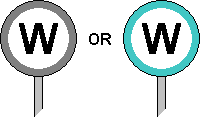|
|
|
Steam locomotives were fitted with whistles which the driver could sound to give warning of the train's approach, for example to staff working on the track. At certain locations, such as on the approach to a level crossing or footpath crossing, a lineside board was installed to instruct drivers to sound the whistle. These continue to be referred to as 'whistle boards', despite modern trains having two-tone horns instead of whistles.
Early whistle boards generally had the word "whistle" spelled out in full [15.1]. Some had additional wording to cater for special circumstances [15.2], for example:
 |
 |
|
[15.1] Whistle Board (e.g. LNER).
Area: Various Usage: High Status: Obsolescent |
[15.2] Whistle Board with additional wording (e.g. Polhill Tunnel, Southern Railway).
Area: Various Usage: Medium Status: Historical |
|---|
From 1965, a new type of whistle board, comprising a black letter "W" on a white circular background [15.4], was being installed on the approaches to several new Automatic Half Barrier (AHB) level crossings on the Southern Region. In May 1967, the Operating Committee recommended that this style of whistle board be adopted as a future standard, leading to their further provision around the network on an experimental basis. Some whistle boards had a non-standard square background [15.5]. British Rail later introduced a standard form of whistle board, which was circular and had a grey or blue border [15.6].
 |
 |
 |
|
[15.4] Whistle Board.
Area: All Areas Usage: High Status: Obsolescent |
[15.5] Whistle Board.
Area: Various Usage: Medium Status: Obsolescent |
[15.6] Whistle Board.

Area: All Areas Usage: High Status: Current |
|---|
Special illuminated whistle signs were provided at Glasgow Central (Scottish Region) in 1971. These could be switched on when trains were stabled in the carriage sidings and it was necessary to warn staff about the line. The signs displayed either a horn symbol [15.7] or the words "sound horn" [15.8]. Illuminated "sound horn" signs were also installed at Lanark in 1973. Those at Lanark were removed in November 1986, while the last examples at Glasgow Central remained until January 2007.
 |
 |
|
[15.7] Illuminated "Sound Horn" Sign.
Area: Glasgow Central Usage: Low Status: Historical |
[15.8] Illuminated "Sound Horn" Sign.
Area: Glasgow Central / Lanark Usage: Low Status: Historical |
|---|
|
New experimental whistle boards were introduced at certain user-worked level crossings on the Scottish Region from 1993. The design of this board is similar to the special speed restriction board provided on the approach to a locally monitored level crossing (see [16.28]), but the speed figure is replaced by a letter "W" [15.9]. Where this sign is provided, the driver must sound the two-tone horn continuously until the train is about 50 yards (46 metres) from the crossing. |
|
|
An unusual variant of whistle board with a red border [15.10] was installed on the Down direction approach to Penrhiwtyn user-worked level crossing, between Briton Ferry and Neath. It was replaced by a standard whistle board (see [15.6]) in March 2019. |
|
|
In response to complaints from residents living close to railway lines on the matter of noise pollution caused by train horns, an amendment was made to the Rule Book in April 2007, which required drivers only to use the low tone of the two-tone horn when passing a whistle board. Despite this, the sounding of both tones of the two-tone horn was deemed to be necessary at certain locations where, as a reminder to drivers, an additional whistle board has been installed below the existing whistle board [15.11]. Several of these additional boards were installed in August 2014 in connection with a trial at numerous level crossings between Kemble and Standish Junction (Western Route). |
|
|
In 2012, a whistle sign comprising a cut-out letter "W" [15.12] was proposed to overcome the problem of graffiti obscuration rendering whistle boards unreadable. Cut-out whistle signs had existed for many years in Northern Ireland. |
|
Where a station is situated between a whistle board and the related level crossing etc., the warning time given to crossing users would be excessive if a train was to stop at the station after sounding its horn at the whistle board. In February 2016, the whistle board on the Up direction approach to Sea Mills user-worked level crossing on the Severn Beach line (Western Route) was provided with a supplementary sign reading "non-stop trains only" on a yellow background [15.13]. Drivers of Up direction trains stopping at Sea Mills station are not required to sound the horn.
At some similar locations, a second whistle board is provided beyond the station, which only applies to stopping trains, and the first whistle board is retained for non-stopping trains only. This is the situation at Bainfield footpath crossing, near Cardross station (Scotland Route), where supplementary plates reading "non-stopping" [15.14] and "stopping" [15.15] were fixed to the relevant Up direction whistle boards in October 2018.
 |
 |
 |
|
[15.13] Whistle Board for non-stopping trains only.
Area: Sea Mills Usage: Low Status: Uncertain |
[15.14] Whistle Board for non-stopping trains only.
Area: Cardross Usage: Low Status: Uncertain |
[15.15] Whistle Board for stopping trains only.

Area: Cardross Usage: Low Status: Uncertain |
|---|
|